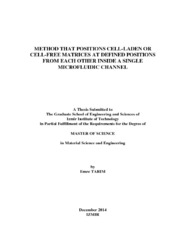Please use this identifier to cite or link to this item:
https://hdl.handle.net/11147/4279Full metadata record
| DC Field | Value | Language |
|---|---|---|
| dc.contributor.advisor | Pesen Okvur, Devrim | en_US |
| dc.contributor.advisor | Özyüzer, Lütfi | en_US |
| dc.contributor.author | Tarım, Emre | - |
| dc.date.accessioned | 2015-05-08T06:55:57Z | |
| dc.date.available | 2015-05-08T06:55:57Z | |
| dc.date.issued | 2014 | |
| dc.identifier.citation | Tarım, E. (2014). Method that positions cell-laden or cell-free matrices at defined positions from each other inside a single microfluidic channel. Unpublished master's thesis, İzmir Institute of Technology, İzmir, Turkey | en_US |
| dc.identifier.uri | http://hdl.handle.net/11147/4279 | |
| dc.description | Thesis (Master)--Izmir Institute of Technology, Material Science and Engineering, Izmir, 2014 | en_US |
| dc.description | Includes bibliographical references (leaves: 54-56) | en_US |
| dc.description | Text in English; Abstract: Turkish and English | en_US |
| dc.description | x, 45 leaves | en_US |
| dc.description.abstract | In recent years, the use of microfluidic has increased in the field of many biological studies. Microfluidic technology has a large area which is a joint product of biology and industry covering all branches of science. The small size of the microfluidic chip offers many advantages in the use of microfluidic. During the analysis, the microfluidic chip offers many advantages such as, use of less material, less waste generation, temporal control, opportunity of analysis under the microscope and high throughput analysis. In addition to these, while microfluidic chip is providing a safe environment for users, via mimicking the physiological environment, it also provides a suitable environment in order to make cell, tissue and organs based assays. Microfluidic devices especially use in cancer studies, chemical analysis, tissue engineering, drug screening, immunology and stem cell differentiation. In this study, we aimed to develop methods depending on the distance to position the MDA-MB 231 breast cancer cells in the microfluidic channels. Firstly, the microfluidic channels were obtained by using the soft lithography and experiments with breast cancer cells were performed using these channels. Breast cancer cells containing matrix was loaded into microfluidic chips and precipitated onto blank matrix by using centrifuge. The aim of repeating this process was to position the breast cancer cells at different distanced locations. | en_US |
| dc.language.iso | en | en_US |
| dc.publisher | Izmir Institute of Technology | en_US |
| dc.rights | info:eu-repo/semantics/openAccess | en_US |
| dc.subject | Microfluidics | en_US |
| dc.subject | Biotechnology | en_US |
| dc.subject | MDA-MB 231 breast cancer cells | en_US |
| dc.title | Method that positions cell-laden or cell-free matrices at defined positions from each other inside a single microfluidic channel | en_US |
| dc.title.alternative | Hücreli ya da hücresiz matrikslerin tek bir mikroakışkan kanal içinde birbirlerinde belirli uzaklıklarda konumlanmasını sağlayan yöntem | en_US |
| dc.type | Master Thesis | en_US |
| dc.institutionauthor | Tarım, Emre | - |
| dc.department | Thesis (Master)--İzmir Institute of Technology, Materials Science and Engineering | en_US |
| dc.relation.publicationcategory | Tez | en_US |
| item.grantfulltext | open | - |
| item.cerifentitytype | Publications | - |
| item.languageiso639-1 | en | - |
| item.openairecristype | http://purl.org/coar/resource_type/c_18cf | - |
| item.fulltext | With Fulltext | - |
| item.openairetype | Master Thesis | - |
| Appears in Collections: | Master Degree / Yüksek Lisans Tezleri Sürdürülebilir Yeşil Kampüs Koleksiyonu / Sustainable Green Campus Collection | |
Files in This Item:
| File | Description | Size | Format | |
|---|---|---|---|---|
| T001302.pdf | MasterThesis | 2.44 MB | Adobe PDF |  View/Open |
CORE Recommender
Page view(s)
140
checked on Jul 22, 2024
Download(s)
60
checked on Jul 22, 2024
Google ScholarTM
Check
Items in GCRIS Repository are protected by copyright, with all rights reserved, unless otherwise indicated.